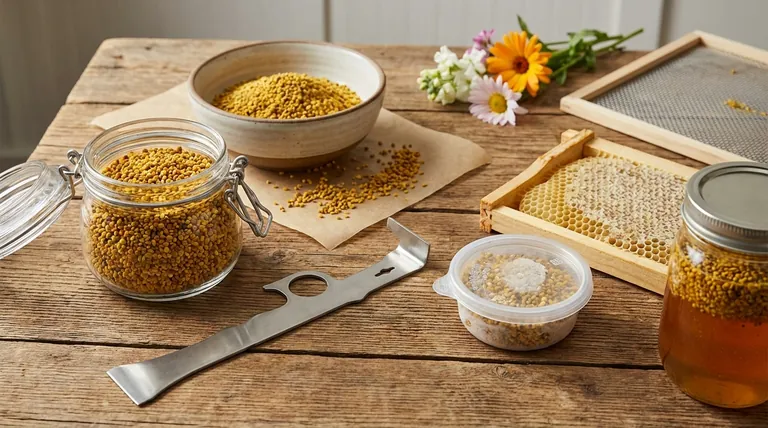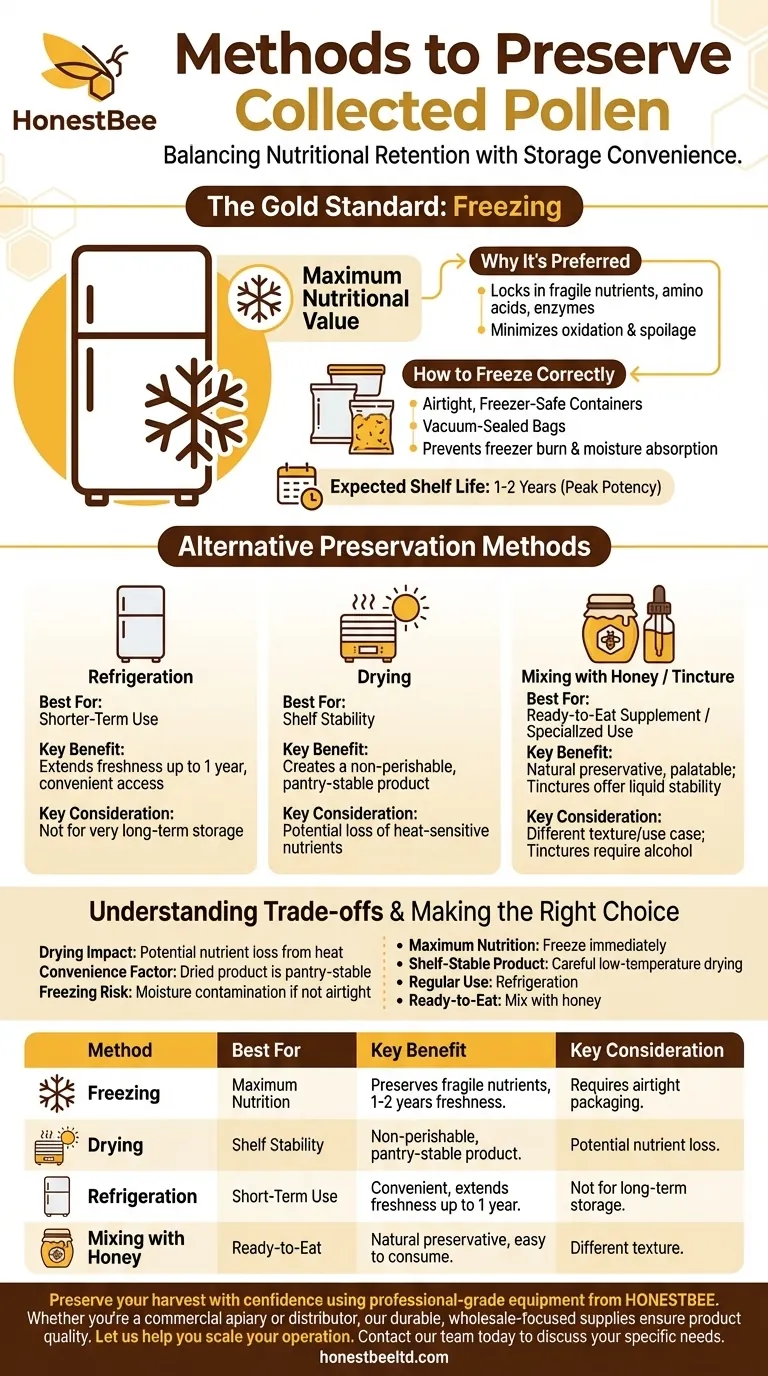The most effective methods for preserving collected pollen are freezing, refrigeration, and drying. Freezing is widely considered the superior approach for maintaining the pollen's full nutritional profile and freshness. For different goals, such as creating a shelf-stable product, methods like careful drying, mixing with honey, or creating a tincture are also viable options.
Choosing the right pollen preservation method is a matter of balancing nutritional retention against storage convenience. Freezing offers the highest fidelity to fresh pollen, while other methods provide shelf-stable alternatives with specific trade-offs.

The Gold Standard: Freezing
Freezing is the preferred method for anyone seeking to preserve the maximum nutritional value of their collected pollen. It effectively halts the degradation of sensitive compounds.
Why Freezing is Preferred
Freezing locks in the pollen's fragile nutrients, amino acids, and enzymes. This process minimizes oxidation and spoilage, keeping the pollen in a state that is as close to fresh as possible.
How to Freeze Pollen Correctly
Proper packaging is critical to success. Store the pollen in airtight, freezer-safe containers or vacuum-sealed bags to prevent freezer burn and shield it from absorbing moisture and odors.
Expected Shelf Life
When stored correctly, frozen bee pollen can maintain its quality for one to two years. Some sources suggest it can be kept indefinitely, but its peak potency is best maintained within that two-year window.
Alternative Preservation Methods
While freezing is ideal for nutrition, other methods offer benefits in terms of convenience and storage requirements.
Refrigeration for Shorter-Term Use
If you plan to use the pollen regularly, refrigeration is a practical option. It can extend the freshness of the pollen for up to one year, making it readily accessible without the need for thawing.
Drying for Shelf Stability
Drying removes moisture, which is the primary catalyst for mold and bacterial growth. This creates a completely shelf-stable product that does not require refrigeration or freezing, making it easy to store and transport.
Mixing with Honey
Creating a pseudo bee bread by mixing fresh pollen with raw honey is another effective technique. Honey is a powerful natural preservative that protects the pollen while creating a palatable, ready-to-eat supplement.
Creating a Tincture
For more specialized applications, pollen can be tinctured. This involves using alcohol to extract and preserve the pollen's beneficial compounds in a liquid, shelf-stable form.
Understanding the Trade-offs
Each preservation method comes with compromises that you must consider.
The Impact of Drying on Nutrients
The primary drawback of drying is potential nutrient loss. The exposure to heat and air, even at low temperatures, can degrade some of the pollen's heat-sensitive vitamins and volatile compounds.
The Convenience Factor
Drying offers unparalleled convenience. A dried, shelf-stable product can be stored in a pantry, which is a significant advantage if freezer or refrigerator space is limited.
The Risk of Improper Freezing
The main pitfall with freezing is moisture contamination. If your container is not truly airtight, condensation can form, leading to clumping and a potential loss of quality over time.
Making the Right Choice for Your Goal
Select your method based on how you intend to use the pollen.
- If your primary focus is maximum nutritional preservation: Freeze your pollen immediately in an airtight, freezer-safe container.
- If your primary focus is creating a shelf-stable product for easy storage: Carefully dry the pollen at a low temperature to minimize nutrient loss.
- If your primary focus is regular or short-term use: Refrigeration offers a convenient balance, keeping the pollen fresh for up to a year.
- If your primary focus is a ready-to-eat supplement: Mixing fresh pollen with raw honey is an excellent way to preserve it while enhancing its usability.
Ultimately, your preservation strategy should directly support your reason for collecting the pollen in the first place.
Summary Table:
| Method | Best For | Key Benefit | Key Consideration |
|---|---|---|---|
| Freezing | Maximum Nutrition | Preserves fragile nutrients, enzymes, and freshness for 1-2 years. | Requires airtight packaging to prevent moisture and freezer burn. |
| Drying | Shelf Stability | Creates a non-perishable, pantry-stable product. | Low heat can cause some loss of heat-sensitive nutrients. |
| Refrigeration | Short-Term Use | Convenient access; extends freshness for up to 1 year. | Not suitable for very long-term storage. |
| Mixing with Honey | Ready-to-Eat Supplement | Honey acts as a natural preservative; easy to consume. | Product has a different texture and use case than pure pollen. |
Preserve your harvest with confidence using professional-grade equipment from HONESTBEE.
Whether you're a commercial apiary managing large volumes or a distributor supplying the market, the right tools are essential for maintaining product quality. HONESTBEE supplies durable, wholesale-focused beekeeping supplies and equipment designed for efficiency and reliability.
Let us help you scale your operation. Contact our team today to discuss your specific needs for pollen processing, storage, and more.
Visual Guide

Related Products
- HONESTBEE Advanced Ergonomic Stainless Steel Hive Tool for Beekeeping
- Professional 3-Bar Frame Grip with Integrated Hive Tool
- High Quality Honey Dehumidifier Dryer Thickening Machine for Beekeeping
- Beehive Handle and Frame Rest Cutting Machine: Your Specialized Hive Machine
- Portable Uncapping Tank Holder Uncapping Bench for Beekeeping
People Also Ask
- Why do hive tools have a hole? Unlock the Secret to Efficient Beekeeping
- Why is it important to compare the progress of different hives? A Beekeeper's Key Diagnostic Tool
- What are the features of a regular hive tool? The Essential Multi-Tool for Every Beekeeper
- What are some common uses of a hive tool? Essential Multi-Purpose Tool for Every Beekeeper
- How should beekeepers handle bees when using a hive tool? Master Calm, Deliberate Techniques



















